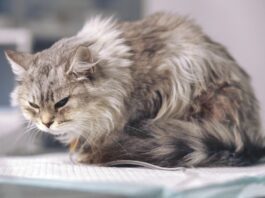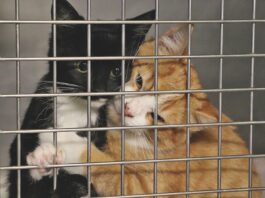Play Biting Is Not Fun
Its cute, at first, when that tiny little kitten leaps at your ankles, swats you a few times, then runs off. But as he grows, this play biting/ scratching can injure you.
Myth Buster: Canned vs. Dry Food
We want the best for our cats, and nutrition plays a vital role in any animals health. But advertising and lay opinions can leave a cat owner wondering whether to feed canned food or dry foods.
Myriad Causes of Mouth Sores
An oral ulcer is almost always a reason to visit your veterinarian. While causes can range from treatable to serious, it can be difficult for you to determine at home. Your veterinarian may do a swab to examine under the microscope or possibly sedate your cat for a thorough oral examination.
Yes, Your Indoor Cat Can Get Fleas
You go to cuddle with your indoor cat and notice what looks like salt and pepper on your white shirt. Since youre a scientist at heart and want to know exactly what those specks are, you shake them off onto a white paper towel and add a drop of water. Oh no! The black specks dissolve into pink. You found flea eggs and flea feces.
Neutered Males Are Spraying
I need information on spraying. I have four neutered males that are housed exclusively indoors, and I am having problems. Can you provide any advice about how best to address this issue?
Cats Hide Signs of Hip Dysplasia
A diagnosis of hip dysplasia might take you by surprise. Usually, a cat comes into the veterinarian because the owner notices that the cat is lame or sore, or less active than normal. Some cats with hip dysplasia will be consistently off in their gait, while other cats only show stiffness after a wild chase through the house.
Teach Your Cat by Shaping Behavior
Cats are super easy to train by using shaping. Shaping is a training technique where you build up to the desired behavior by rewarding steps in the right direction. To teach shaking hands, for example, you might first put your hand under her paw so she touches it. Give her a special treat, like a tiny piece of chicken, for the touch. Repeat, offering your hand and moving it closer to her to see if and when shell touch it.
When Kitty Battles Dementia
With dramatic advancements in feline veterinary care, our beloved cats are living longer and healthier lives. A cat who lives to be 20 years old is the approximate equivalent of a 96-year-old person. Unfortunately, all cats eventually show signs of aging.
Help for Stressed Cats
A study at UC-Davis looked at using gabapentin for short-term stress relief in cats traveling to the veterinary clinic. Gabapentin has been used in cats for seizure and pain control, but human studies show some reduction of anxiety as well. An earlier study used gabapentin for feral cats involved in trap/neuter/release programs to reduce fear responses.
Are Essential Oils Safe for Your Cat?
The growing popularity of essential oils for health, ambiance, and behavior modification has led to real feline-safety concerns. The problem is that cats have a unique set up for enzymatically metabolizing many compounds in their liver, so something safe to use around dogs and humans may still be toxic to your cat.
Stem Cells for Feline Asthma Woes
Stem-cell injections are common in veterinary medicine, but mostly for joint and lameness problems in dogs and horses. A pilot study in the Journal of Feline Medicine and Surgery may change things for cats with asthma.
Licking Off Patches of Hair
My cat likes to lick himself on both shoulder blades, shortening the hair to the skin in some places. The areas are 2 by 5 inches. He used to have several smaller spots that hed licked until the hair was totally gone and the skin was getting raw from all of the licking. Now its just two bigger patches on the shoulders, but not down to the bare skin all of the time.















